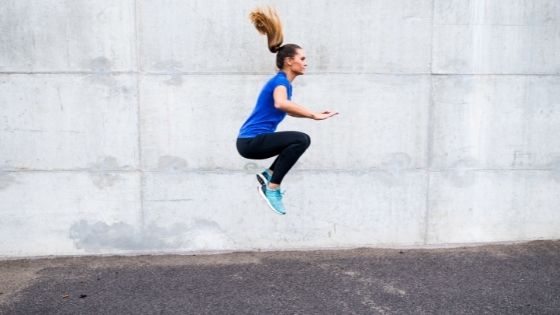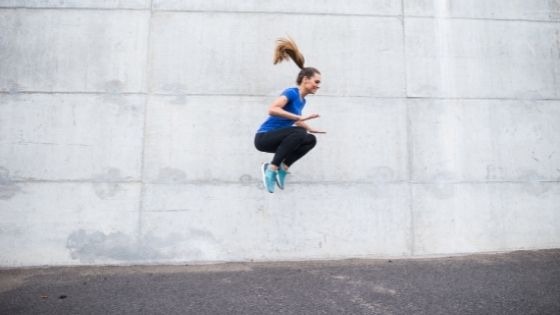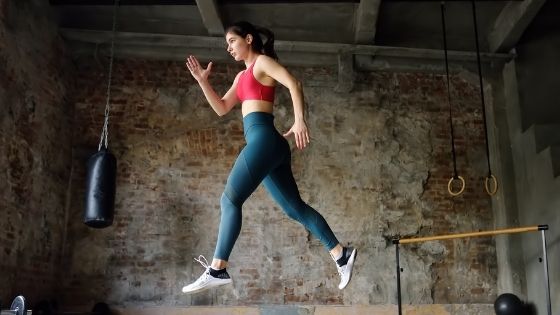How to Jump Higher? 18 Exercises That'll Have You Flying High!

Do you want to know how to jump higher? Jumping is a great way to stay in shape and have fun. It’s also an important part of many sports, like basketball, volleyball, and soccer.
But if you want to be able to jump high enough for your favorite sport or activity, it takes more than just practice! It would be best if you had the right strength training exercises too.
Here are all you need to know and some effective tips on how you can get started with jumping higher today!
Why is it important to know how to jump higher?
It's important to know how to jump higher because it determines how high you can get off the ground and whether or not you will be able to jump at any sport in the future.
To learn how to jump higher, you need to know a few things about jumping up and getting off the ground.
We normally jump when we get up in the morning because it is easy to push ourselves away from the floor. If you do this, when you try to jump up again, you are pushing yourself away from the ground, making it more likely to jump higher vertically than just to the side.
When you jump up, it is important to push your lower body out. If you push your legs out too much, it will make you jump up a lot higher. So push your legs out to the sides of your body when jumping up off of the ground if possible.
Muscles used for jumping

Your muscles you use when you jump. A jump is the result of triple extension simultaneous and explosive extension of your torso, wrists, and ankles. In addition, it stretches your glutes, hamstrings, and quadriceps.
It builds strength in your abdominal muscles; you can even improve your basketball game! Triple extension is behind a jump. No matter if you're a weightlifter coming up from a clean-and-jerk run or a sprinter taking off for the last leg of the race, or an NBA player going to play, you're a ballgame. It's the same muscles that are making Olympic lifting and sprinting possible.
How can you increase your vertical leap?
It is important to increase your vertical leap if you want to jump higher. However, to increase your vertical leap, you must eat and exercise the right way. Therefore, I will give you some quick but very effective tips to increase your vertical leap starting today!
The first thing you need to do is start eating healthier. You can't be making bad decisions about what you put into your body if you want to increase your vertical jump. Keep in mind that the foods you eat directly affect how you perform athletically.
Move on and start exercising more. Many exercises can help you get better at jumping, but don't just go to the gym and do different exercises without a plan. Have some structure, so it is easier to get better.
Do you have access to a track? If so, you should practice running at top speed every other day. You have to run because it will increase your vertical leap by forcing your body to adapt amazingly. Don't underestimate the power of running. It can really help to improve your vertical leap!
What is power?
When you increase your speed of the jump, you will increase your vertical by about 10 percent. Power = Force + Velocity = Maximum strength, and speed is people's speed.
That is essential you jump higher. You must be stronger. Maximum strength equals maximum power. When you increase your speed, you will increase your vertical by about 10 percent. People's speed is essential. They have to be strong or faster. If you're strong, you will jump high above people. Every person who plays sports like boxing, basketball, football, etc., should focus on these essential tips to see your performance in sports.
The three steps of a jump
I've stated the three most important things you need to increase your vertical leap: if you want to know how to jump higher, you need to eat right. Second, if you want to learn how to jump higher, you need exercise, and you need to run your sprints, and third, you should do strength training. Finally, you have to lift as much weight as possible.
Ankle flexion is the way you bend your ankle to jump higher, and if for some reason you can't, then try jumping in 3 sections so you can avoid injury.
As you are about to jump, try doing a few arm swings to help propel the movement and make you jump higher! Make sure you don't lift your legs over your head, as this will increase any chances of injury. As you lower down to do so in a controlled manner, you don't want an injury.
The best exercises for jumping higher

Here's a list of a few exercises for jumping higher. These are the most effective means to increase vertical jump height, and I have ranked them in order of importance.
Box Jumps (unweighted)
This is the most effective jump training exercise for improving your vertical leap, period! It works on strength in the legs and hips, balance, and coordination of fast-twitch muscle fibers. This exercise will improve your jumping performance in any athletic event where you need the quick reaction and explosive power. You can perform these using a set of stairs or jump up on a solid platform from about 18 inches (usually the height of an average kitchen counter).
You should try to jump forward as high on this kind of box as possible. When height isn't a critical factor, you should try to jump as high and as fast as possible when doing this exercise.
Don't forget to keep your knees slightly bent while you do it so that you can land softly on the box. For an added challenge, wear a weight vest or hold dumbbells in each hand.
This will put a bit more emphasis on your shoulders, but it doesn't have to be done if you're using the box jumps as a 'warm-up' exercise.
Vertical Jump Shrugs (or Power Cleans)
If you are looking to jump higher with maximum power and explosiveness, the clean is one of the best exercises to do so. The clean is a full-body exercise that will also help you improve your jumping by increasing the strength in your legs, core, and shoulders.
If you want to improve on your vertical jump, but don't have access to weights or want more range of motion (you can jump higher without doing it with weights), then clapping push-ups are the best exercises you can do. You have to focus on clapping your hands as you land, and you will be amazed at how much of a difference this makes to your jumping.
This is also one of the most effective ways to improve vertical jump height in a short timeframe. This really does work!
Depth Jumps (from 24" box)
The height of your jump platform will determine your ability to perform depth jumps, so you need a solid one.
You do this exercise as you would any other type of jump. You drop from that standing position onto the floor, and then you leap forward to back up onto the same box. When you land, you need to jump really high. You don't want your knees to hit the floor when you land. You maintain your balance by absorbing the force of this landing throughout your whole body. The best part about it is you improve your ability to absorb impact while you're jumping at the same time!
If you are looking for a greater challenge and using a higher box, you can try jumping down from the top of the box rather than just dropping.
Squat jumps
A jump squat is the power-packed HIIT version of a standard squat. This exercise works on your leg muscles, glutes, and lower abs.
Squat jumps are a great exercise you can do to improve your max jump height and explore barbell or trap-bar squatting. You can use dumbbells or weights you control for squat jumps or add weight using a barbell or trap-bar squat.
- You have to be feet hip-width, and the tips of the feet facing outward at an angle of 45º.
- The back straight and knees drawing a 90° angle with each other from our squat position, we propel ourselves into take-off for explosively jump.
Depth Jump
The depth jump is preceded by the strong eccentric (negative)-muscle force caused by dropped downward from raised surfaces. When you start, you want to make sure you are landing on the box with your feet about 1 cm apart from each other.
From there, you will immediately be jumping as high in the air as you can, and you want to do this for a total of 10-12 reps.
When you land, you want to make sure your knees are not hyper-flexing because it can cause a lot of damage to your knees if you are doing it too hard or for too long of a time span.
Make sure you are not rushing through this exercise because you will not be working out the muscle groups or muscles you need if you rush.
Medicine Ball throw
If you want to be able to jump higher, you need to have good upper body strength. Throwing a medicine ball teaches you how you can generate power through your chest, shoulders, and arms. It will also help you get more power out of your lower body as you learn to extend your knees and hips while you throw properly.
Jump Rope
If you don't have access to weights, you can always jump rope! This is one of the best exercises you can do if you are trying to improve your vertical leap. You jump over the rope as you swing it, and you really need to try and increase your speed.
It may not be quite as effective as other exercises you can do, but you should really give this one a good go if you are looking for a way of boosting your vertical jump. 9. Squat Thrusts If you want to get better at jumping, you need to be focused on improving your power. You can learn that you can generate a lot of force by doing this simple exercise. You should focus on keeping your back straight as you jump up, and you should try and land softly with your knees slightly bent.
Single-Leg Squats
If you are looking for a challenging exercise that you can do to improve your jumping, you need to try single-leg squats. You will put your balance under some serious pressure during this exercise, but it's worth it for how much you will improve your jumping. Of course, you have to focus on keeping your chest up, and you should try to keep your back straight as you do this exercise.
High Knees Running
To really get the most out of your running, you can add in some high knees into the mix! This simple exercise works really well at boosting your vertical jump because you are jumping up as you land!
You have to work on increasing the number of high knees you do in your running. You can start by completing 5 jumps for each rep, but you should try to build up to run 10-15 reps with high knees.
Rear-footed Elevated Split Squat
The rear-foot raised split squat is a great exercise for those with hip problems and you. It takes less pressure to your back, prevents you from shearing your spine in the classic back squat, and you can determine what distance you want to put one foot (your front foot) at if you are moving it.
For example, when you kneel on the ground, you want your knee below your heel on the top of your foot or further backward.
Reverse Lunge
If you want to learn how to land at your feet when you jump, you should make lunges. They are fantastic for stimulating the muscles in your legs and give you that extra burst of energy you need to fly through the air. Do three or four sets of 6-10 reps on each side once or twice per week!
Romanian Deadlifting
Deadlifting is one of the best exercises you can do for your legs. It's great for your back, too, your quads, hamstrings, glutes, and core.
You can get it somewhere, or you can use a heavy backpack with some boxes inside in your hands. Perform 3-4 sets of 6-10 reps a few times per week.
Stand your knee width apart, your knees bent at a right angle, and your back neutral, then you press your hips back into the waistband of your jeans. Next, push your glutes out of your chair with your hands on your hip bones. This is a rep for deadlifting.
You can do this exercise using an incline or flat bench.
Broad jumps
One of the best exercises you can do to improve your jumping height is to do broad jumps. You'll need to have a band attached to the fixed bracket and put another one around your hips when you do broad jumps.
The band will pull your hips back, and you'll need to jump explosively for you to keep going. To track your progress, you can draw a line on the floor where you're capable of jumping and try to get further than you were before.
Try repeating this exercise or picking up speed in the next round by trying to jump farther in the next round as well.
Jumping jacks
Jumping Jacks are a kind of plyometric exercise that helps you jump higher while strengthening the lower body. They also raise the speed of your heart whilst removing your body from its regular path of motion. This exercise is beneficial if you want to improve performance in activities such as quick moves.
Burpees
Jumping is a skill you can improve with exercises, and you will also gain strength, explosiveness, and endurance as you do so. Some of the best jumping exercises are burpees. In a burpee, you start in a squat position, thrust your legs out behind you to come into a pushup position, then explode upwards to bring your legs into your hands into the air in front of you, and you land back in your squat position.
Rebounding
That's why you need to rebounding on your mini-trampoline. You'll feel the air in between you and the ground when you're bouncing around, which will get you higher, and you won't be putting stress on your joints. You should bounce for a specific amount of time and think about how you're going to fly as you've never before: rebounding is the way to get there.
Lift and Leap Jump Training
Lift and leap jump training will help you jump higher. All you have to do is a mix between two and eight legs when you're jumping. When you start to slow down, your workout is done. Don't use squats, swings, or any exercise that will make you not be as good at jumping as you were before.
Kettlebell swings
There are many exercises you can use to increase your jumping power. Kettlebell swings are one of the best because you use your lower body to create momentum while you swing the kettlebell forward. Keep your chest more open, and you will be able to gain more momentum.
Conclusion
Want to jump higher? It’s not all about your legs. In fact, the science of jumping is more complicated than you think! When it comes to leaping into the air for a dunk or volleyball spike, many factors contribute to how high and far you go.
The height of your take-off point makes a difference in terms of where your foot (or shoe) hits the ground when you land, especially if it's wet or slippery.
Your arm swing can help generate momentum upwards by throwing them back behind as they come down from their initial position overhead before landing.
And while most people might think "leg power" contributes largely to how high we leap, research has shown this isn't actually true. (Trusted Sources 1*, 2*, 3*)
Medically reviewed and approved by Nataniel Josue M D.
